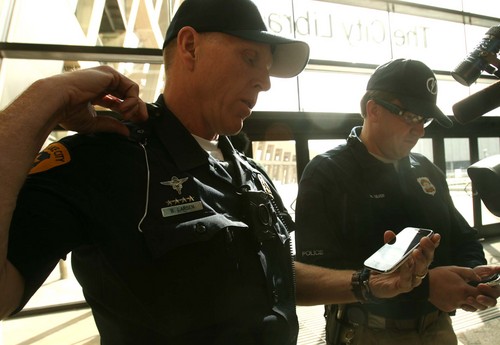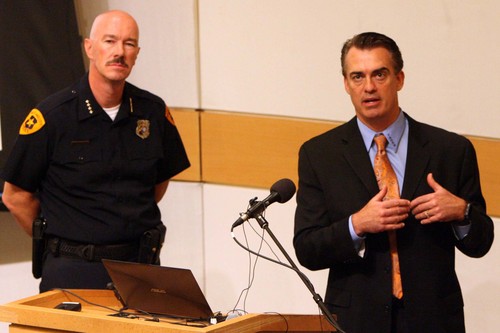This is an archived article that was published on sltrib.com in 2014, and information in the article may be outdated. It is provided only for personal research purposes and may not be reprinted.
Smile: You're on police camera.
Well, in some cities. The Park City, American Fork and Perry police have started equipping their officers with body cameras to record interactions with the public, and the Salt Lake City police are training their officers to adopt the new technology as well. Besides hard evidence that can help solve cases and clear up complaints, the cameras are meant to keep both the police and the public accountable.
About a month ago, Park City police outfitted all 31 of their officers with the cameras, which clip to their chests. There is no mystery about when the Park City police's cameras are on: when the officer flips a switch, a lens cover slides open and people can see the obvious, green camera.
"We're not doing anything secretively. We want the public to know," said Capt. Phil Kirk. Besides evidence collection, accountability is a major function of the cameras. Reviewing the footage, Kirk has noticed that their officers are explaining everything more, not just for the public's benefit, but for the cameras as well. "Everybody's on a little better behavior."
Perry Mayor Jerry Nelson told the Standard-Examiner that the cameras, which the police started wearing a few weeks ago, can protect the officers from unfounded complaints of excessive force, adding that "it keeps everybody above board, both the people they pull over and the officer themselves."
A study out of California showed body cameras reduce both citizen complaints and officers' use of force. That state's Rialto Police Department saw an 88 percent decline in complaints during the year in which they were wearing cameras, compared with the year before when they were not, according to the International Herald Tribune. The Rialto police also used force 60 percent less that year than the year before.
But that added accountability comes with a learning curve: Finding that balance between facing the camera in the right direction and when that has to take a backseat so the officers can do their job safely.
The chest cameras that Park City, Perry and American Fork police use keep officers from having to wear sunglasses or a hat, like the Salt Lake City police's, but the central placement means officers have to be more mindful of how they position themselves. As a general rule, officers try to stand angled away from people to keep their guns just out of reach. But that stance can point the lens the wrong way.
"There are advantages and disadvantages to each [model]," Kirk said. "… They're taking a while to get used to."
It is helpful when there is more than one cop at the scene, so that while one is doing the talking, the other is capturing the scene, Kirk said. But even if the camera is pointed away, the audio "is really good, too," the captain added.
The American Fork police were the first to adopt the cameras in 2007 and ran into the same issue, said Sgt. Joshua Stilson. They eventually found a balance, with safety, not video, as the top priority.
Stilson could not speak to whether the cameras have had any effect on the relationship between the department's 33 officers and the public, particularly since the cameras they use look like the officer's standard issue microphone clipped to his or her shirt. But the evidence they collect have played a "very beneficial" role in a number of cases, he said.
West Valley City Police Chief Lee Russo said when he served as police chief in Covington, Ky., he equipped his entire department with them.
"I love them," Russo said. "The bottom line is video doesn't lie. They generally cleared an officer of any wrongdoing."
He said they were also a positive addition when it came to filming interviews with witnesses and suspects, filming crime scenes and interacting with the public in general. They made resolving complaints about officer conduct "very swift."
He said his department also continued to use dash-cam video in addition to the body cameras, and he noted that there were sometimes issues where an unexpected incident happened right in front of an officer and there was no time to activate the body camera.
He said West Valley City also owns some body cameras thanks to a grant and has had discussions about using them department-wide.
"It's certainly a topic for discussion and consideration," he said. "I'd love to do it, but 1. there are cost considerations and 2. there are a lot of infrastructure [processes] you need to have in place."
The Salt Lake City police hope to outfit all of their first-line responders — a large number of whom comprise the patrol division — by their next fiscal year, which for them begins in July. Police Chief Chris Burbank has said he is confident that the cameras are the future of the police force. The SLCPD has stopped buying dashboard cameras for police cruisers and is redirecting those funds to body cameras.
The SLCPD's camera of choice is a small, lightweight one that an officer can clip to a headband, sunglasses or shirt collar. Burbank has said the SLCPD went with eye- and shoulder-level cameras as opposed to chest-level cameras because, with those, the view can be obscured as soon as an officer holds up his or her gun.
About 90 officers are already wearing them, but for the most part, they are still in a training phase and video is not kept as evidence, said Detective Rick Wall.
"This can be a good thing," ACLU of Utah Executive Director Karen McCreary said earlier this year. She looks forward to the evidence and transparency the videos could provide. But privacy is also a concern whenever it comes to collecting information on the public, such as how securely it is stored and who has access, and she looks forward to reviewing the finalized policies.
Burbank said the footage, which would be housed on a third-party company's servers, is likely to be kept and disposed of on a similar schedule as the rest of SLCPD's evidence. Only select people will have access to the videos and the power to delete them.
Russo said there are several issues that need to be dealt with before a department can implement body cameras.
"There's a lot to deal with in terms of storing and collecting data," he said, noting policies need to be put in place regarding when an officer activates them. There needs to be a balance to protect an officer's privacy, like say when the officer is talking with their own family or using the restroom. People's constitutional rights also need to be balanced since the cameras will be filming on private property.
A department also has to consider state record's laws that dictate how long a video must be stored.
He said when it comes to storing that data, no department has the capability to store what are literally "terabytes of data." Storing that for five years is practically impossible "unless you're going to build an NSA center."
At least a few of Utah's larger agencies are considering the technology. Ogden and Provo police and the Weber and Utah County Sheriff's Offices are all exploring the possibility of adopting body cameras, but they have put them off for various reasons. Cost is a consideration, and most of them want to wait and see if the technology advances and makes the camera a more tantalizing buy.
Twitter: @mikeypanda







